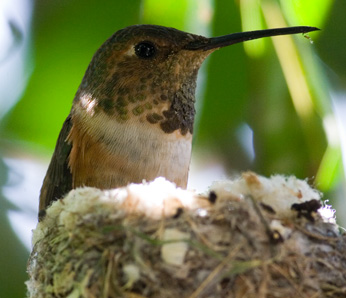Allen's Hummingbird
From Wikipedia, the free encyclopedia
[Photo] Allen's Hummingbird (Selasphorus sasin) adult female tending nest. At a backyard nest (Daylight photograph taken from partial cover). Photo by Asicnewbie. License: public domain
The Allen's Hummingbird, Selasphorus sasin, is a species of hummingbird, a family of small passerine birds.
The Allen's Hummingbird is a small bird, with mature adults reaching only 3 to 3½ inches in length. The male Allen's has a green back and forehead, with rust-colored rufous flanks, rump, and tail. The male's throat is also an iridescent orange-red. The female and immature Allen's Hummingbirds are similarly colored, but lack the iridescent throat patch, instead having a series of speckles on their throat. Females are mostly green, featuring rufous colors only on the tail, which also has white tips. The female and immature Allen's Hummingbirds are so similar to the female Rufous Hummingbird that the two are almost indistinguishable in the field. Both species' breeding seasons and ranges are common factors used to differentiate between the two species in a particular geographical area.
The Allen's Hummingbird is common only in the brushy woods, gardens, and meadows of coastal California from Santa Barbara north, and a minuscule portion of lower Oregon. The nominate race of Allen's Hummingbird, S.s. sasin is migratory, and winters along the Pacific coast of central Mexico. A second race S.s. sedentarius is a permanent resident on the Channel Islands off southern California. This population colonized the Palos Verdes Peninsula of Los Angeles County in the 1960s and has since spread over much of Los Angeles and Orange Counties.
The courtship flight of the male Allen's Hummingbird is a frantic back and forth flight arc of about 25 feet similar to the motion of a swinging pendulum, followed by a high-speed dive from about 100 feet. The male is also highly aggressive and territorial. Hot-tempered despite its diminutive stature, a male Allen's Hummingbird will chase any other males from its territory, as well as any other hummingbird species, and they have even been known to attack and rout predatory birds several times larger than themselves such as kestrels and hawks.
The Allen's Hummingbird constructs its nest out of plant fibers, down, and weed stems, coating the nest with lichens to give it structure. The nest is placed above ground on a tree branch or the stalk or stem of a plant. The female lays two white eggs, which she will incubate for 15 to 17 days. The young will leave the nest about three weeks after hatching. The mother will continue to feed the fledglings for several more weeks, then the young are left to fend for themselves.
Like all hummingbirds, the Allen's Hummingbird's high rate of metabolism requires it to feed frequently, about every 10 to 15 minutes. The Allen's Hummingbird drinks nectar from flowers, as well as eating any small insects it finds crawling around the flower blossom, which provide it with needed protein.
A hybrid between this species and Anna's Hummingbird has been described as Floresi's Hummingbird, "Selasphorus" floresii (Ridgway, 1909; Taylor, 1909).
http://en.wikipedia.org/wiki/Allen%27s_Hummingbird
| The text in this page is based on the copyrighted Wikipedia article shown in above URL. It is used under the GNU Free Documentation License. You may redistribute it, verbatim or modified, providing that you comply with the terms of the GFDL. |
|

